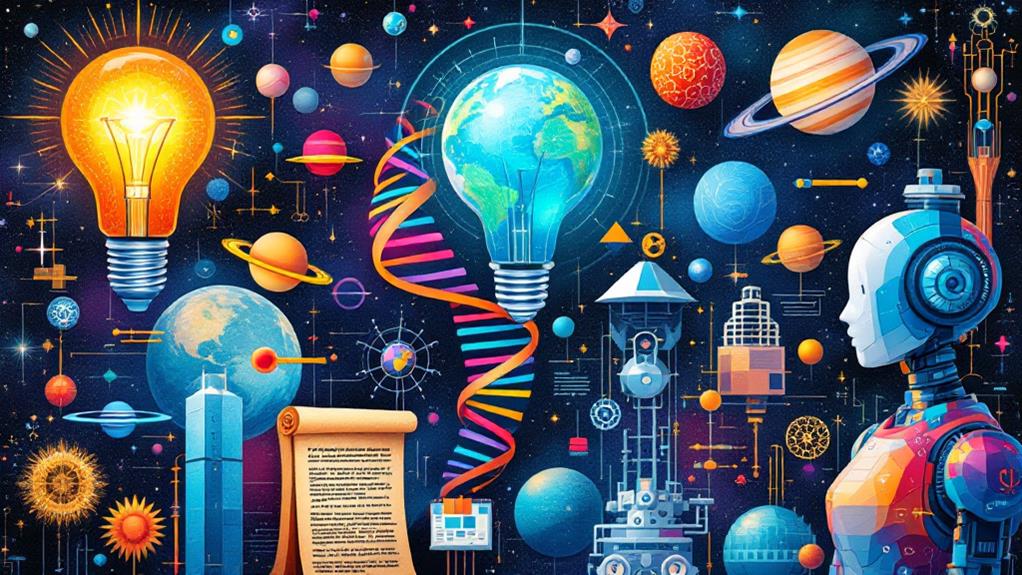The Greatest Discoveries of All Time: Milestones in Science and Innovation

You're living in a world shaped by incredible revelations and innovations. Mastering fire transformed survival and community life, while the invention of the wheel transformed transportation. The printing press sparked a literacy explosion, reshaping society's fabric. Grasping gravity's pull revealed universal mysteries, and germ theory improved public health. Darwin's theory of evolution changed our understanding of life's diversity, and DNA unraveled life's genetic code. Quantum mechanics altered the fundamentals of physics, and the internet has connected the globe. These milestones showcase humanity's brilliance, hinting at more wonders within reach as you investigate further.
Fire: The First Spark
Few revelations have had as profound an impact on human evolution as fire. Imagine you're part of an early civilization, uncovering fire's potential. Suddenly, you've got a powerful energy source at your fingertips, transforming your survival strategies. You use fire to cook, enhancing cooking techniques that make food more digestible and safe. This newfound ability fosters cultural significance, as meals become central to community gatherings and bonding.
Fire doesn't just revolutionize diet; it provides warmth and safety, essential for thriving in harsh environments. You gather around the flames, feeling secure from predators and the cold. Fire also plays a role in tool development, helping you shape and harden materials, creating more effective instruments for hunting and building.
Beyond survival, fire's versatility extends to communication. With signaling methods using smoke and flames, you can send messages across vast distances, connecting communities. Fire rituals emerge, forming a backbone of spiritual and social practices, shaping your cultural identity.
As you harness fire, you also witness ecosystem changes, as burned landscapes give rise to new growth. This revelation's influence echoes throughout time, laying the foundation for countless innovations and shaping humanity's destiny.
The Wheel's Revolutionary Roll
In the annals of human innovation, the wheel stands as a vital breakthrough, reshaping how you move and connect with the world. This simple yet profound invention transformed ancient transportation, making it possible to transport goods and people over long distances with ease. Imagine trying to move heavy objects without wheels—it's nearly impossible. With them, though, transporting becomes an effortless endeavor, and the world feels more connected.
You might not realize it, but the wheel is more than just a round object. It's a cornerstone of technological advancement. Its development marked a turning point that led to countless innovations across diverse industries. From carts and chariots in ancient times to bicycles and automobiles today, the wheel's impact is undeniable. It laid the groundwork for modern engineering marvels and continues to play a role in everyday life.
Embracing the wheel's revolutionary roll means recognizing its influence on the evolution of human civilization. It symbolizes humanity's ability to harness creativity and problem-solving to overcome challenges. By understanding its significance, you gain a deeper appreciation for the technological advancements that shape your world and drive progress forward.
Printing Press Breakthrough

The invention of the printing press in the mid-15th century marked a monumental leap in the dissemination of knowledge. You can imagine how groundbreaking type setting was, allowing for the mass production of books that transformed societies. Suddenly, information wasn't confined to the elite; it became accessible to a much wider audience. This change sparked a cultural revolution, fueling a literacy explosion across Europe.
With more people able to read, knowledge dissemination took on a life of its own, leading to significant social change. The ability to share information quickly and widely meant that ideas could spread faster than ever. This newfound information accessibility also had a profound political influence, as it enabled the spread of revolutionary ideas and challenged the status quo. People were empowered to question authorities and seek reforms.
Moreover, the printing press wasn't just about text; it improved artistic expression too, allowing artists to reproduce their works and reach broader audiences. This technological advancement set the stage for future innovations and shaped the modern world. By altering how information was shared, the printing press transformed society in ways you continue to benefit from today.
Gravity's Unseen Force
Among the many forces that shape our universe, gravity stands as a fundamental yet invisible influence. You can't see it, but it's the Universal Attraction that keeps planets orbiting stars and governs the motion of galaxies. Newton's Laws initially introduced you to this mysterious force, explaining how objects attract one another. But it was Einstein's Relativity that expanded your understanding, revealing how gravity warps space-time itself.
Gravitational Waves, ripples in the fabric of space-time, further confirmed Einstein's theories. These waves let you observe colossal cosmic events, like Black Holes colliding. Speaking of Black Holes, these enigmatic entities are regions where gravity is so intense that not even light can escape. They illustrate gravity's extreme potential and its Cosmic Influence.
Tidal Forces, a result of gravitational interactions, affect everything from ocean tides on Earth to the stability of entire galaxies. Meanwhile, Dark Matter, an unseen component of the universe, hints at a gravitational force that shapes cosmic structures on a grand scale. It's through these phenomena that you grasp gravity's unseen yet powerful role, connecting everything from the smallest particles to the vast expanses of the universe.
Germ Theory Emergence

As you ponder the vastness of the universe shaped by gravity's unseen hand, shift your focus to another invisible force that altered our understanding of life itself: germs. This revelation, known as germ theory, transformed the way you view health and disease. Before this theory, the cause of illnesses was a mystery. With the emergence of germ theory, you learned that microbial pathogens, not mystical forces or imbalances, were responsible for diseases.
Germ theory laid the foundation for modern sanitation practices. By recognizing that germs spread through unclean environments, you could implement measures to reduce their transmission. This knowledge led to cleaner water, safer food, and more effective waste disposal. As a result, public health improved dramatically, and life expectancy soared.
Disease prevention became a proactive effort. Vaccines, antiseptics, and antibiotics emerged as powerful tools to combat these tiny invaders. By understanding how germs operate, you could develop strategies to outsmart them, leading to fewer outbreaks and healthier communities. The realization that these microscopic entities had such a massive impact on your life marked a turning point, ushering in a period where science and health became intertwined in unprecedented ways.
Electricity: Power Unleashed
When you flip a switch and light floods the room, you experience the marvel of electricity—an invisible force that altered the world. From the crackle of static electricity to the hum of power generation, electricity powers modern life. You rely on complex electrical circuits designed through advanced electrical engineering to guarantee everything runs smoothly. Our daily lives are intertwined with this force, as it drives innovations like electric vehicles and powers cities with renewable energy.
Electricity's expedition is fascinating, marked by breakthroughs that changed the way you live:
- Electromagnetic Waves: Harnessed by pioneers like Maxwell and Hertz, these waves enable wireless communication, from radio to Wi-Fi.
- Battery Technology: Portable energy storage has transformed electronics, enabling everything from smartphones to electric vehicles.
- Renewable Energy: Solar, wind, and hydroelectric power are key to sustainable power generation, reducing reliance on fossil fuels.
- Electric Vehicles: These eco-friendly cars are altering transportation, reducing emissions, and driving technological advancements.
As you investigate these milestones, you see how electricity, once a curiosity, became a cornerstone of technological progress. The innovations in this field continue to shape a sustainable, electrified future for everyone.
Evolution's Insightful Theory

Darwin's groundbreaking theory of evolution reshaped our understanding of life on Earth. By introducing natural selection, Darwin explained how adaptation mechanisms drive changes in species over time. You've probably noticed how different environments lead to unique evolutionary traits in species. This is due to genetic drift and natural selection working together to promote species diversification. When you investigate the fossil record, you see evolutionary evidence supporting the idea of common ancestry among diverse life forms.
By examining the phylogenetic tree, you can trace these relationships and better understand the connections between species. Evolution isn't just about physical traits; it also influences evolutionary psychology, shedding light on behavioral aspects of humans and other animals. Have you ever wondered why certain traits or behaviors persist? Evolutionary psychology provides insights into why these traits might have been advantageous.
Moreover, coevolution dynamics reveal how species interact and evolve together, impacting each other's development. For instance, when a predator and its prey evolve in response to each other, both species undergo changes that guarantee survival. Embracing Darwin's theory helps you appreciate the intricate web of life and the ongoing processes that shape the natural world.
DNA: Life's Blueprint
DNA, the remarkable double helix structure, is often referred to as life's blueprint. You've likely heard about its crucial role in genetic engineering and biotechnology advancements. At its core, DNA is a code that determines hereditary traits and influences everything from eye color to susceptibility to certain diseases. With the advent of DNA sequencing, scientists have decoded this intricate language, allowing breakthroughs in molecular biology and personalized medicine.
Consider these four fascinating applications of DNA:
- Gene Therapy: By altering genetic material, you can potentially correct genetic disorders, offering hope for conditions that were once considered incurable.
- CRISPR Technology: This revolutionary tool lets you edit genes with precision, opening doors to treat diseases and improve crop resilience, enhancing genetic diversity.
- Forensic Science: DNA's unique signatures help solve crimes and identify individuals with unmatched accuracy, providing justice and closure.
- Evolutionary Genetics: Studying DNA sequences across species helps you understand evolutionary paths, illustrating the interconnectedness of life.
These applications underscore DNA's essential role in science and technology, continually reshaping how you understand health, identity, and the natural world. Each revelation builds on the last, paving the way for future innovations.
Quantum Mechanics Unraveled

As you marvel at the intricacies of DNA and its profound impact on life sciences, another field of science beckons with its own mysteries: quantum mechanics. You're diving into a world where the rules of classical physics don't apply. Here, particles can exist in multiple states simultaneously, known as superposition states. The famous thought experiment Schrödinger's cat exemplifies this bewildering concept.
In this quantum domain, wave particle duality allows particles like electrons to exhibit both particle and wave characteristics. The uncertainty principle challenges your ability to know both the position and momentum of a particle with precision. Quantum entanglement links particles over vast distances, creating seemingly instantaneous connections, while the observer effect suggests that the mere act of watching can alter quantum states.
Quantum tunneling allows particles to pass through barriers that seem insurmountable, playing a vital role in technologies like quantum computing. As you investigate these concepts, you'll encounter quantum teleportation, where information is transferred between entangled particles. However, the decoherence phenomenon often disrupts these delicate quantum states, posing challenges for practical applications. Quantum mechanics unravels the mysteries of the universe, redefining your understanding of reality.
Internet's Global Impact
The internet has transformed the way you connect with the world, transforming communication, commerce, and culture on a global scale. It has redefined digital connectivity, allowing you to interact with people across continents effortlessly. This technological innovation has paved the way for significant social transformation, enabling virtual communities to flourish and fostering cultural exchange like never before.
With information accessibility at your fingertips, you can access a vast array of knowledge in seconds. This has democratized learning and bridged educational gaps, providing everyone with the tools to improve their understanding of the world. The internet's role in global communication cannot be overstated; it has made it possible to share ideas and collaborate in real-time, irrespective of geographical boundaries.
Economic development has also seen a significant increase, as businesses harness the power of the internet to reach global markets. E-commerce platforms allow you to shop from anywhere, creating a thriving digital economy. Here's how the internet impacts you daily:
- Social media: Connect with friends and family worldwide.
- Online learning: Access courses and educational resources.
- E-commerce: Shop and sell products globally.
- Remote work: Collaborate with teams across the globe.
The internet continues to shape your world in unprecedented ways.



